June, 1949
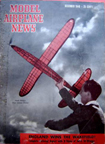
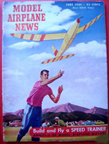
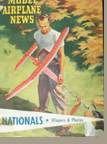
Celebration of Wakefield Rules Free-Flight Models
Model Airplane News Cover for December, 1948 and June, 1949
England Wins the Wakefield Cup!
Frank Ehling's rubber powered free-flight stick model is on the cover of the December, 1948 issue
Bill Winter and Walt Schroeder's "Eureka" is on the cover of the June, 1949 issue.
The tedious process of winding the rubber motor is on the cover of the October, 1949 Issue Click to Enlarge
The "Wakefield" (or Wakefield Cup Competition) is sort of the "Grand-Daddy" of all model airplane contests, begun in 1911 by Lord Wakefield of Hythe at a time when model airplanes flew higher, faster and longer than the "real thing". The rules have changed over the years, but basically it is a contest to see who can build a model that will fly for the longest time over constraints of size and motive power.
In the case of 1948, there were several constraints:
- Everything, including the propellor had to be made "from scratch" by the "Builder of the Model" (BOM)
- Wing area was restricted to about 200 square inches
- Maximum weight was about 8 ounces
- The fuselage had to have a minimum cross-section
- The plane had to "Rise Off the Ground" (ROG) to take off -- it could not be "thrown" as shown on the cover....
- In later competitions, the amount of rubber used was limited to about 80 grams
- The plane must fly three times during the competition
This is an ultra-competitive event that requires detailed knowledge of aerodynamics as well as great skill in model craftsmanship. The airplane has to be rugged because it must survive three trials -- however, ruggedness adds weight. Big wings could catch thermals and updrafts, keeping the plane aloft -- but are limited by the area rule. The fuselage has to be big enough to be "useful" -- it cannot be reduced to a "stick". Finally, the plane has to have some sort of landing gear to facillitate takeoff.
The 1948 Wakefield cup was very noteworthy because it was the first such competition held since 1939, since World War II had put all such pursuits on hold. Thus, nearly 10 years of new ideas and new technology were brought to the contest. The reigning champion was an American named Richard Korda who won an upset victory in 1939 -- and had been doing a brisk business selling kits for his winning model.

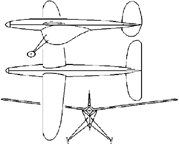
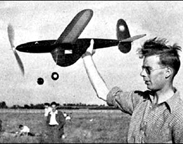
The Winner in 1948
left: the Wakefield Cup middle: "Jaguar" the winning Model
right: Roy Chesterton holding "Jaguar"
Click to Enlarge
The 1948 contest was hed in Akron, Ohio on August 27. (One wonders why the December issue uses an exclamation point to announce the three month old news of England's victory). It seems that Ted Evans, a hobby store owner in England had kept modelling alive through the Blitz and in the process had created "Jaguar" a new look in Wakefield competition. The entire 3-man English team was flying variants on the Jaguar that each member had made under the "BOM" rule. Evans and another Brit ran afoul of a bad crosswind and their planes were wrecked. Roy Chesterton, who was only 23 (and 14 years old when the last competition was held) won the contest with a time of eight minutes, 32 seconds. Korda, now 33, finished 13th.
The article in Model Airplane News borders on the sour grapes as Korda is quoted as attributing the victory to a mysterious "Dunlop Black Rubber" that was only available in England. However, this would be the last ever victory for either Roy Chesterton or England in the Wakefield competition.
Here is some video from contests involving Wakefield type models from the general period of the 1948 competition, including the tedious process of winding the rubber motor with a hand drill. About three minutes are alloted to wind about 1,000 turns.
Frank Ehling (1918-2008) was one of the most prolific designers og model airplanes in the history of aviation. H won his first contest at age 12, and just went up from there. He excelled in all aspects of modelling, but is probably best known as "Mr. Free Flight". He was an ardent advocate of making modeling accessible to all and designed many "beginner" models that built confidence in newcomers to the sport. Here is one of his most memorable designs, "Sure-Fire."

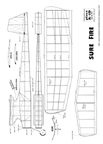
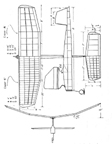
Roy Ehling and "Sure-Fire"
Click to Enlarge
Bill Winter and Walt Schroeder are quite noteworthy because each became editor of Model Airplane News, Bill from about 1951-1959 and Walt from 1969 to the 1970s. Both were very active in model design and presented their approach to building a plane that could be a serious Wakefield contender. The plane was called Eureka, the result of many failures. The design considerations and plans are given in the article.

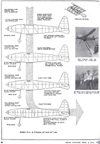

Eureka Wakefield Competitor
William Winter and Walter Schroeder
Click to Enlarge
Finally, this is "Duster", another Wakefield competitor deigned by Joe Bilgri. The first page shows the use of a winder to activate the rubber motor.


Eureka Wakefield Competitor
William Winter and Walter Schroeder
Click to Enlarge

Click to go back and select another cover.
Counter for the Entire Site (not just this page..)
Home | About Lindy | Last Week's Reviews | Upcoming Events | 1940s Collecibles
The Guide - Establishments - Travel - Accessories
Music | Links | Photo Gallery | Extras | Contact